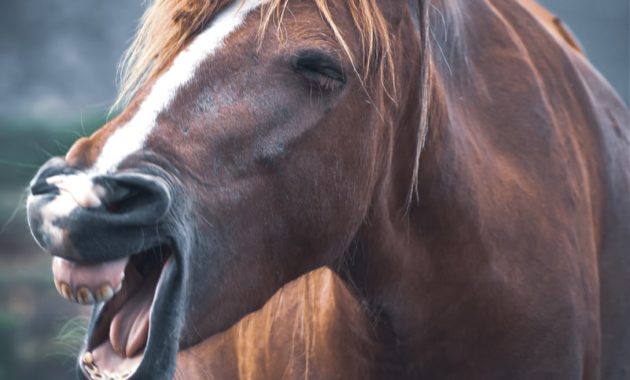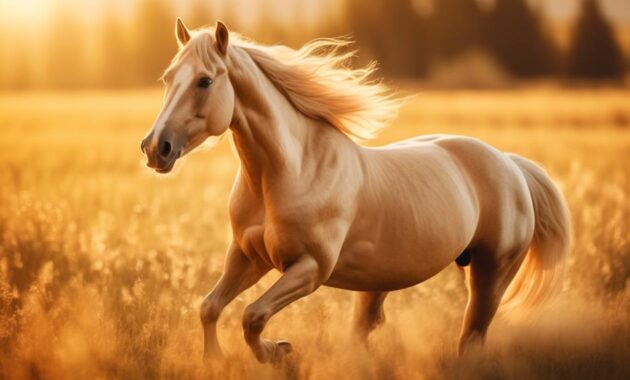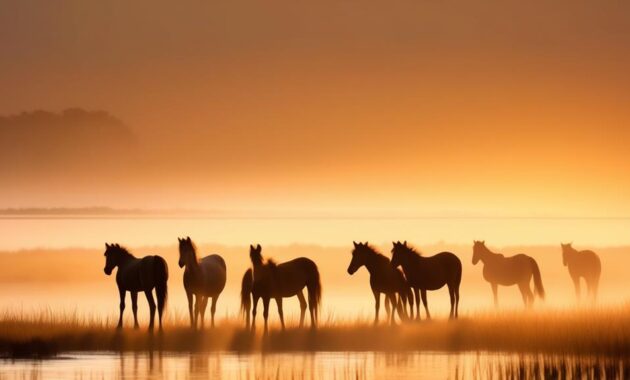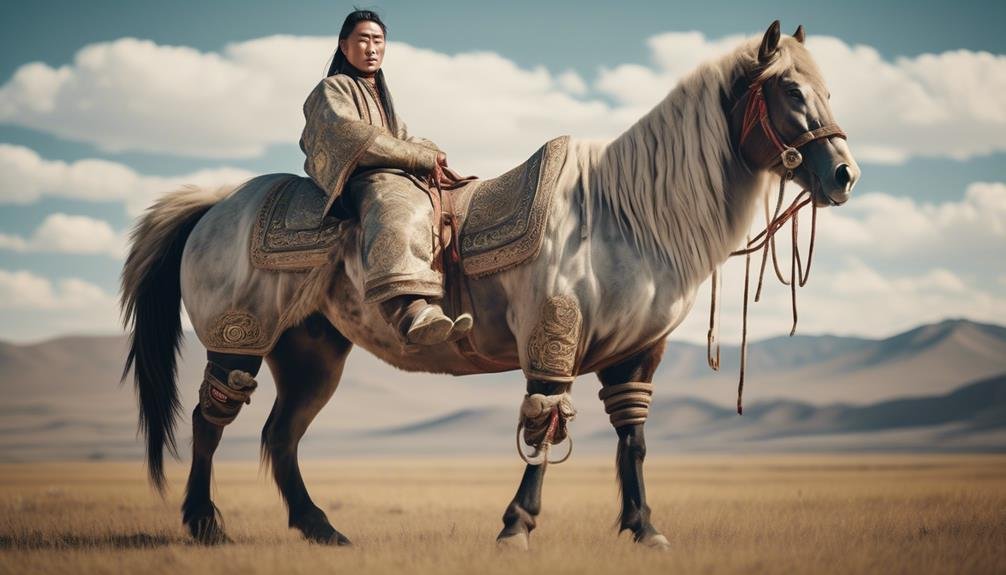
Prepare to be captivated by the remarkable world of the ancient Mongolian horse, a breed that has stood the test of time and remained loyal and versatile throughout the centuries.
Dating back to 2000 BC, these majestic creatures possess a short, stocky, and strong physique, making them an enduring symbol of power and resilience. With a rich history that influenced the development of other equine breeds, the Mongolian horse played a crucial role in shaping the course of history.
But what sets these horses apart from others? What secrets lie within their unique features and characteristics?
Join us as we uncover the mysteries and beauty of the ancient Mongolian horse, a breed like no other.
Key Takeaways
- The Mongolian horse is one of the oldest breeds, dating back to 2000 BC, and has influenced the development of other equine breeds in Asia and Europe.
- Mongolian horses have a calm, friendly, and loyal temperament, making them suitable for horse owners and riders with some experience.
- There are four types of Mongolian horses based on different regions in Mongolia: Steppe, Gobi, Mountain, and Forest. Each type has its own characteristics and body structure.
- Regular grooming sessions, using specific tools, are important for the health and bonding of Mongolian horses.
Physical Characteristics of the Ancient Mongolian Horse
The physical characteristics of the ancient Mongolian horse exhibit a unique combination of strength, agility, and adaptability. Standing at varying heights and weighing around 600 pounds, these horses have a short, stocky, and robust physique.
With a lifespan of 20 to 40 years, they come in a wide range of colors including roan, brown, white, gray, shun, bay, dun, black, and palomino. These horses have played a significant role in the development of other equine breeds in Asia and Europe.
Although not officially recognized by equine breed organizations, they're diligently maintained by the indigenous and nomadic people of Mongolia. Their exceptional temperament is calm, friendly, reliable, and loyal, making them best suited for horse owners and riders with some experience.
The Mongolian horse is truly a versatile and talented breed, though it may require some initial effort to work with.
Rich History of the Mongolian Horse Breed
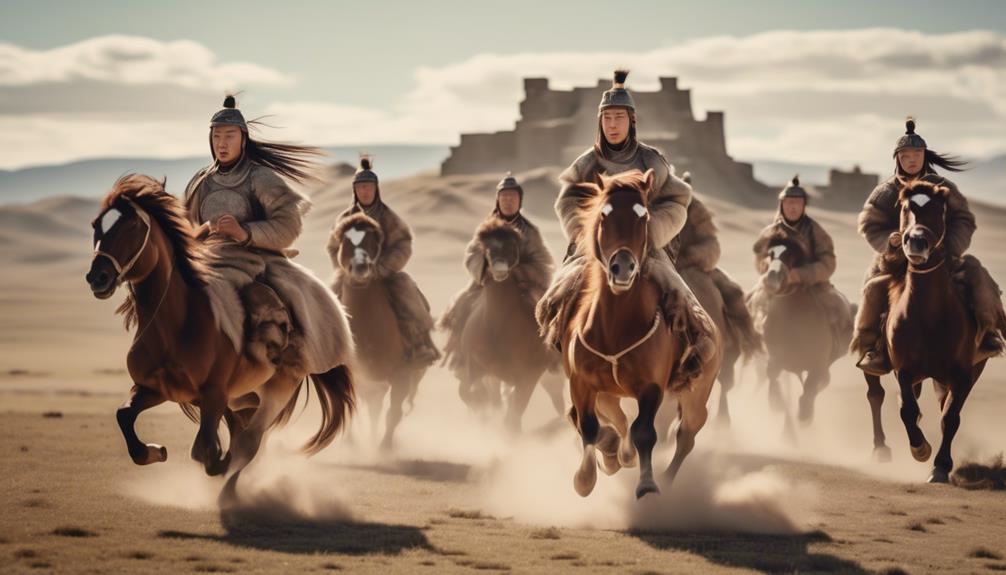
As we delve into the rich history of the Mongolian Horse Breed, it's fascinating to explore how these ancient horses have shaped the equine world throughout the ages.
- Mongolian horses have a history dating back to 2000 BC, making them one of the oldest breeds.
- These horses played a crucial role in the expansion of the Mongol Empire under Genghis Khan in the 13th century.
- The Mongolian horse influenced the development of other equine breeds in Asia and Europe.
Despite their significant contributions, the Mongolian horse isn't officially recognized by equine breed organizations.
- Today, the breed is maintained by indigenous and nomadic people in Mongolia, preserving its unique heritage and cultural significance.
Through centuries of loyalty and versatility, the Mongolian horse continues to be a symbol of strength and resilience, leaving an indelible mark on the history of the equine world.
Lifespan and Size of the Mongolian Horse
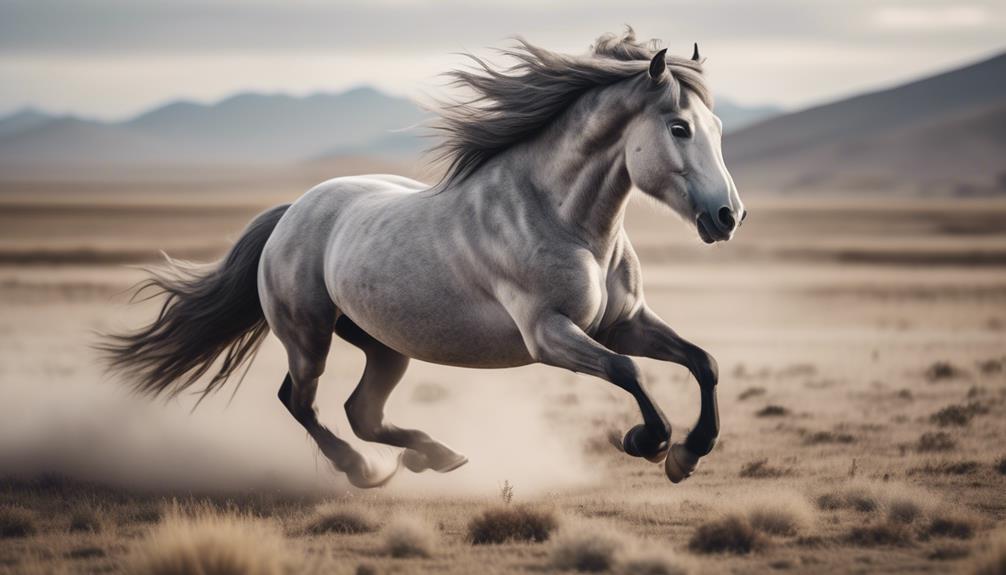
With a lifespan ranging from 20 to 40 years, the Mongolian horse is known for its remarkable endurance and longevity. This makes it a valuable companion for many years. In terms of size, the Mongolian horse is typically short and stocky, standing at varying heights but weighing around 600 pounds. To provide a visual representation, here is a table showcasing the different types of Mongolian horses based on their region in Mongolia:
| Type | Description |
|---|---|
| Steppe | Faster and smaller |
| Gobi | Desert horse, smallest type |
| Mountain | Mid-sized type, similar body structure to Altai Horse |
| Forest | Heaviest and largest type |
Through their diverse sizes and long lifespans, Mongolian horses continue to capture the attention of horse enthusiasts worldwide.
Diverse Colors of the Mongolian Horse
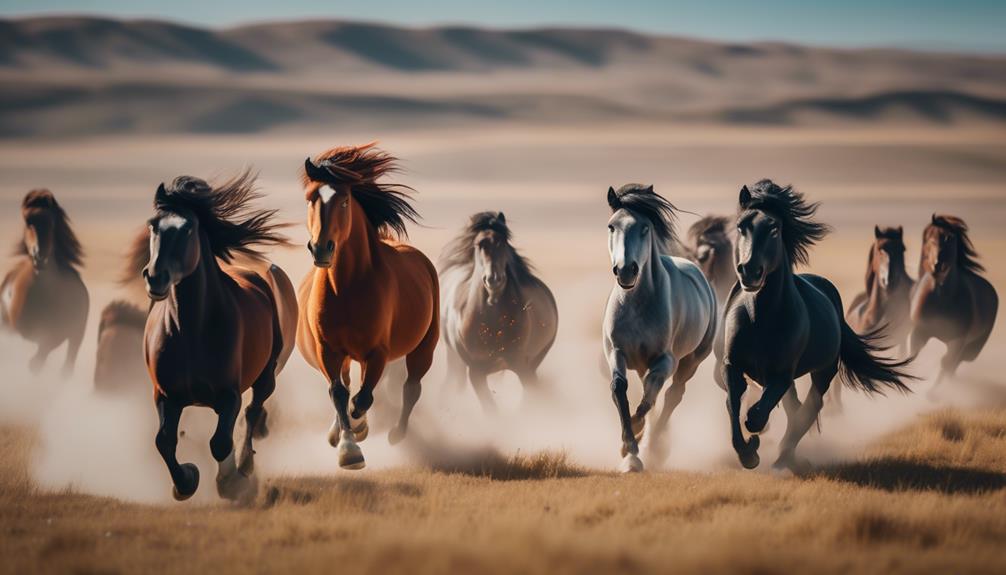
Mongolian horses exhibit a wide array of colors, ranging from roan and brown to white, gray, shun, bay, dun, black, and palomino. The diverse colors of these horses add to their beauty and allure.
Here are some interesting facts about the colors of Mongolian horses:
- Roan: Mongolian horses can have a roan coat, which is a mixture of white and colored hairs.
- Bay: A bay coat color is characterized by a reddish-brown body with black points on the legs, mane, and tail.
- Dun: Dun is a color that ranges from light yellowish to a grayish-brown shade.
- Palomino: Palomino horses have a golden coat with a white or beige mane and tail.
- Gray: Mongolian horses can also have a gray coat, which can range from light to dark gray.
These various colors make each Mongolian horse unique and captivating to behold. Whether it's the stunning roan or the elegant gray, the diverse colors of these horses truly showcase their beauty and individuality.
Influence of the Mongolian Horse on Other Breeds
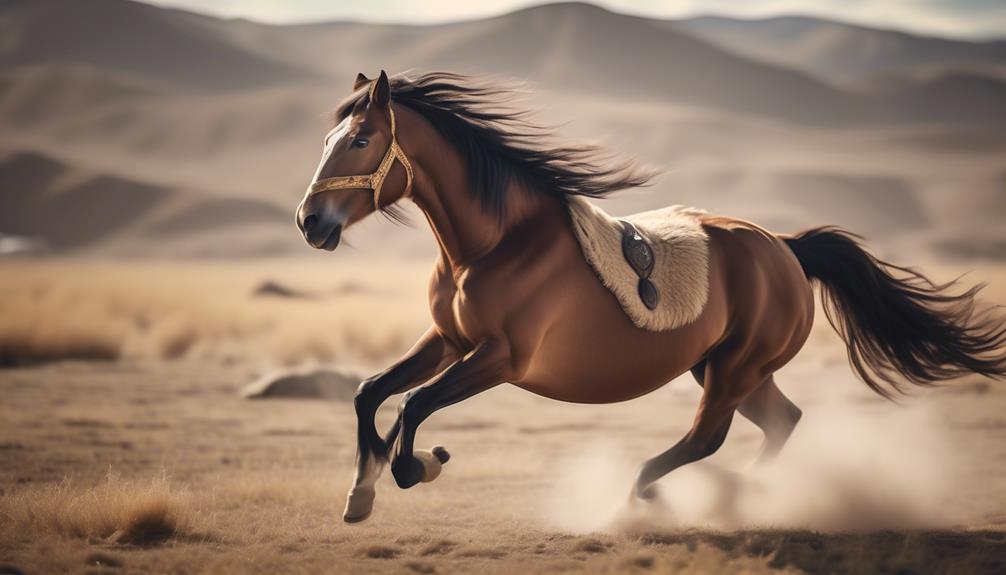
The ancient Mongolian horse breed has left a lasting impact on the development of various equine breeds in Asia and Europe. This influence can be seen in the table below:
| Breed | Characteristics | Influence |
|---|---|---|
| Cardigan Welsh Corgi | Oldest known breed, developed for herding cattle, suited for both outdoor and indoor living | Mongolian horse's versatility and adaptability influenced the Cardigan Welsh Corgi's ability to thrive in different environments. |
| English Springer Spaniel | Known for obedience and friendliness, part of the gun dog group | Mongolian horse's calm temperament may have influenced the English Springer Spaniel's friendly and obedient nature. |
| Bull Terrier | Loyal and energetic breed, unique appearance with larger heads and smooth faces | The Mongolian horse's loyalty and energy may have influenced the Bull Terrier's loyal and energetic nature. |
The Mongolian horse's influence on these breeds can be seen in their temperament, adaptability, and physical characteristics. This demonstrates the breed's versatility and its ability to contribute to the development of other equine breeds.
Genghis Khan and the Mongolian Horse in War
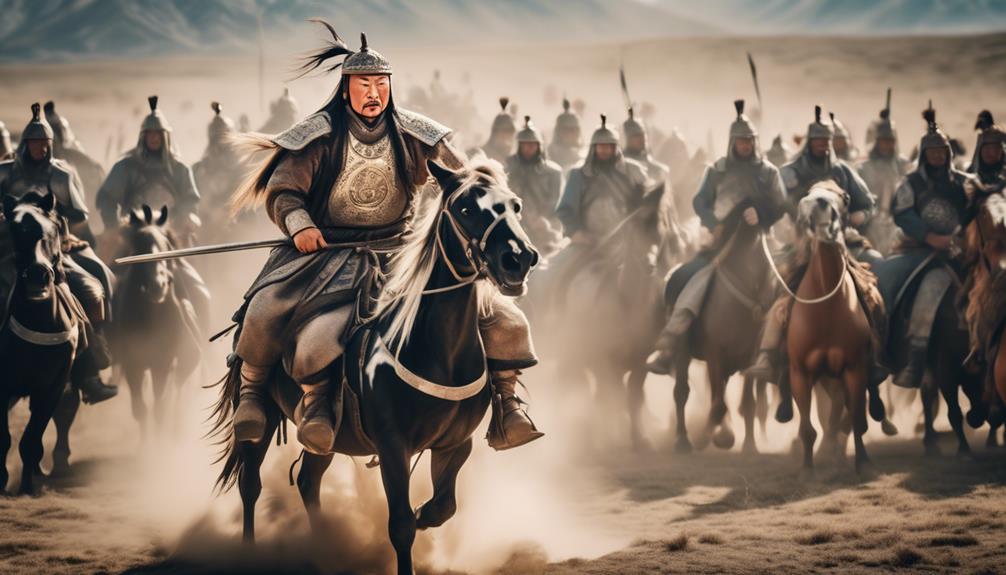
After witnessing the versatility and adaptability of the Mongolian horse in influencing the development of other equine breeds, it's fascinating to explore the role of Genghis Khan and the Mongolian horse in war.
- Genghis Khan relied heavily on the Mongolian horse for his military campaigns.
- The Mongolian horse's stamina and endurance allowed the Mongol warriors to cover vast distances.
- Its agility and surefootedness made it effective in mountainous terrains and harsh environments.
- The Mongolian horse's compact size and strength allowed for quick maneuvers and surprise attacks.
- Its calm temperament made it easier to handle in the chaos of battle.
The symbiotic relationship between Genghis Khan and the Mongolian horse was crucial in the success of the Mongol Empire's conquests. The Mongolian horse's unique characteristics made it an invaluable asset on the battlefield, aiding in the swift expansion of the Mongol Empire.
Recognition Status of the Mongolian Horse Breed
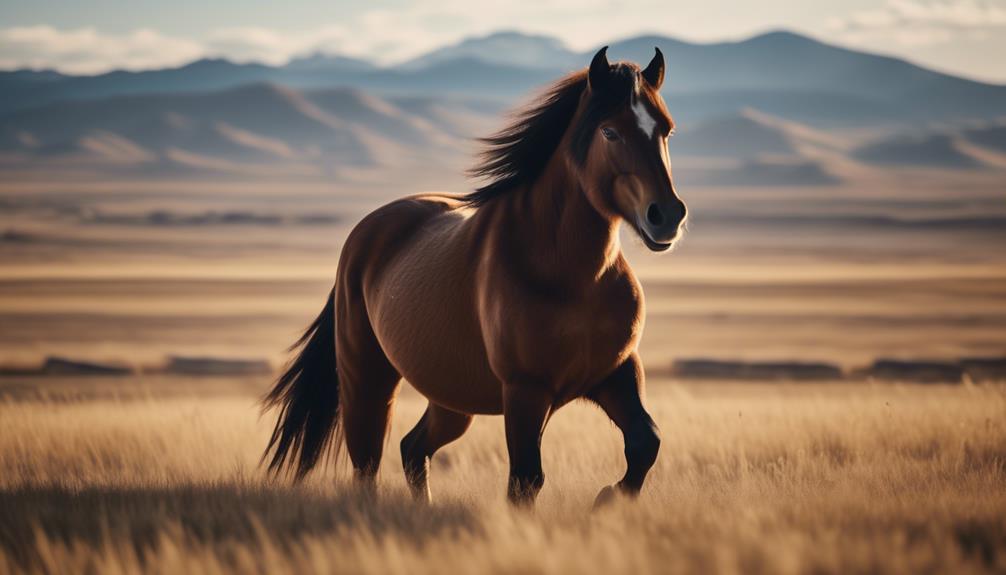
The recognition status of the ancient Mongolian horse breed has been a topic of discussion among equine breed organizations. Currently, the Mongolian horse isn't officially recognized by these organizations. Despite its historical significance and unique characteristics, the breed hasn't met the criteria for recognition. This could be due to various factors, such as limited documentation and research on the breed, as well as the breed's isolation in Mongolia.
However, it's important to note that recognition by breed organizations doesn't diminish the value and importance of the Mongolian horse. It remains a beloved and cherished breed, maintained by indigenous and nomadic people in Mongolia. The loyalty, versatility, and cultural significance of the Mongolian horse continue to be celebrated by those who appreciate its remarkable qualities.
Preservation by Indigenous and Nomadic People
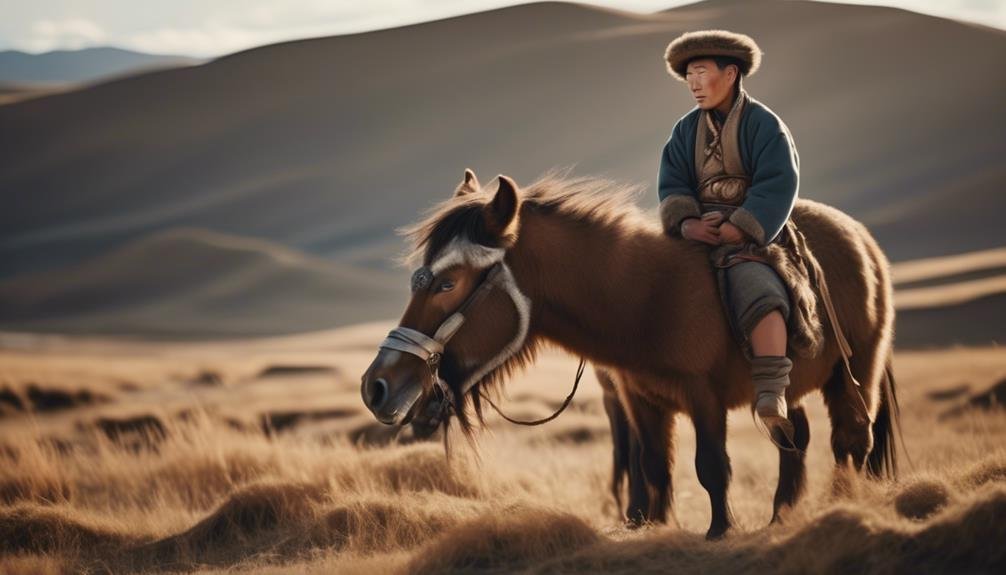
Preserved by the indigenous and nomadic people of Mongolia, the ancient Mongolian horse breed holds a significant place in their culture and heritage. The preservation efforts by these communities have ensured the survival of this remarkable breed throughout the centuries.
Here are five ways in which the indigenous and nomadic people have contributed to the preservation of the Mongolian horse:
- Traditional breeding practices: Indigenous and nomadic people have passed down their knowledge of selective breeding techniques from generation to generation, ensuring the purity and quality of the Mongolian horse breed.
- Nomadic lifestyle: The nomadic lifestyle of these communities allows the horses to roam freely in vast open spaces, promoting their natural instincts and physical development.
- Sustainable grazing practices: Indigenous and nomadic people have a deep understanding of the land and practice sustainable grazing methods, ensuring ample food supply for the horses.
- Cultural significance: The Mongolian horse has deep cultural significance for the indigenous and nomadic people, who value and cherish their relationship with these animals.
- Ecotourism initiatives: Indigenous and nomadic people have embraced ecotourism as a means to preserve the Mongolian horse breed, allowing visitors to experience the breed firsthand and learn about its importance in their culture.
Through their dedicated efforts, the indigenous and nomadic people of Mongolia have played a crucial role in preserving the ancient Mongolian horse breed for future generations.
Temperament Traits of the Mongolian Horse
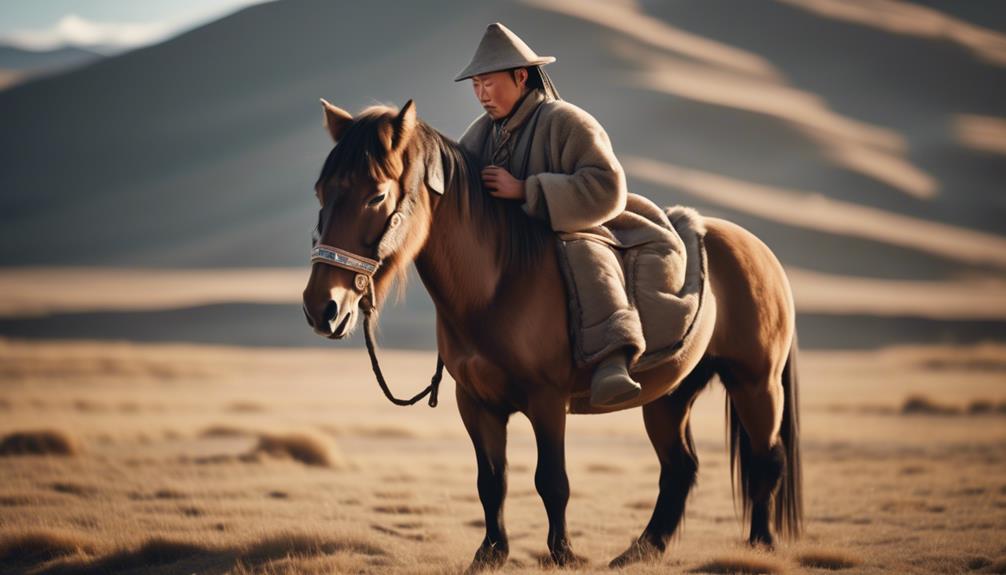
The Mongolian horse is known for its calm and friendly temperament. This breed is renowned for its affectionate and affable personality, making it a great choice for horse owners and riders with some experience. While the Mongolian horse can be versatile and talented, it may require some initial patience and understanding to work with. Interestingly, the Mongolian horse is linked to Scandinavian breeds and the Icelandic Horse. In Mongolia, there are four types of Mongolian horse based on different regions: Steppe, Gobi, Mountain, and Forest. Each type has its own unique characteristics and abilities. The table below provides a summary of these types:
| Type | Description |
|---|---|
| Steppe | Faster and smaller horse |
| Gobi | Smallest type, adapted to desert conditions |
| Mountain | Mid-sized type, similar body structure to Altai |
| Forest | Heaviest and largest type, suited for forest areas |
Types of Mongolian Horse Based on Regions
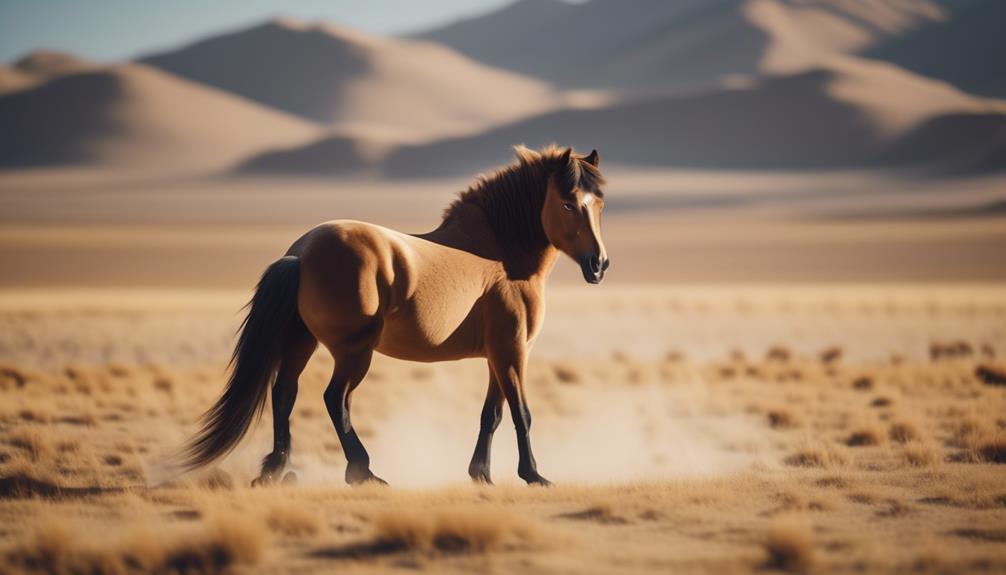
To understand the diversity of the Mongolian horse breed, let's explore the different types based on the regions they originate from.
- Steppe: Faster and smaller type.
- Gobi: Desert horse, smallest type.
- Mountain: Mid-sized type, similar body structure to Altai Horse.
- Forest: Heaviest and largest type.
The Mongolian horse breed showcases a remarkable range of types, each uniquely adapted to their specific regions.
The Steppe type is known for its agility and speed, making it ideal for long-distance travel.
The Gobi type, on the other hand, is smaller in size and perfectly suited for navigating the harsh desert terrain.
The Mountain type shares a similar body structure to the Altai Horse and is well-suited for mountainous regions.
Finally, the Forest type is the heaviest and largest of the Mongolian horse types, making it suitable for carrying heavier loads.
These distinct types demonstrate the versatility and adaptability of the Mongolian horse breed.
Grooming Tips for the Mongolian Horse
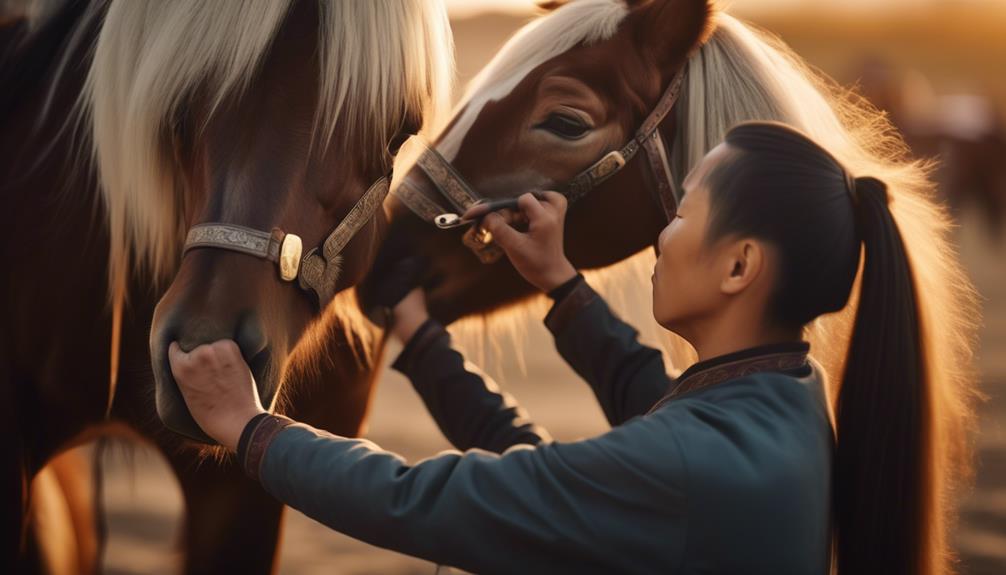
Regular grooming is essential for maintaining the health and bond with your Mongolian horse. To keep your horse looking its best, use a curry comb, body finishing brush, dandy brush, and shedding blade for cleaning. These tools will help remove dirt, debris, and loose hair from your horse's coat.
Additionally, use a mane comb and tail brush to detangle and smooth the hair. Don't forget to clean your horse's hooves with a hoof pick, checking for any infections or injuries.
Finally, use a soft cloth to clean sensitive areas like the eyes and ears.
Importance of Regular Grooming Sessions
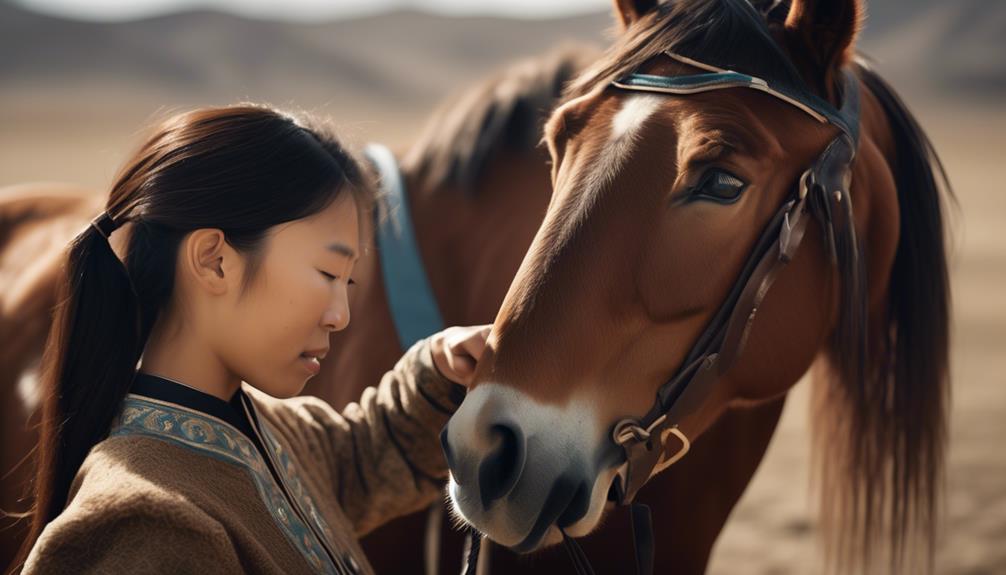
Regular grooming sessions are crucial for maintaining the health and bond with your Mongolian horse. By taking the time to groom your horse regularly, you aren't only keeping them clean and looking their best, but you're also ensuring their overall well-being. Here are five reasons why regular grooming is important for your Mongolian horse:
- Prevents skin conditions and infections: Regular grooming helps to remove dirt, sweat, and debris from your horse's coat, preventing the buildup of bacteria and fungi that can cause skin conditions and infections.
- Promotes healthy circulation: Brushing your horse's coat stimulates blood flow to the skin, promoting healthy circulation and keeping their muscles and tissues in optimal condition.
- Enhances bonding: Spending time grooming your horse allows you to build a strong bond with them. It provides an opportunity for you to connect with your horse on a deeper level and establish trust and mutual respect.
- Detects health issues early: During grooming sessions, you have the chance to thoroughly examine your horse's body. This allows you to identify any cuts, bruises, lumps, or other abnormalities that may require veterinary attention.
- Improves coat quality: Regular brushing distributes the natural oils in your horse's coat, giving it a healthy shine. It also helps to remove loose hair and dead skin cells, promoting a strong and lustrous coat.
Tools and Techniques for Grooming the Mongolian Horse
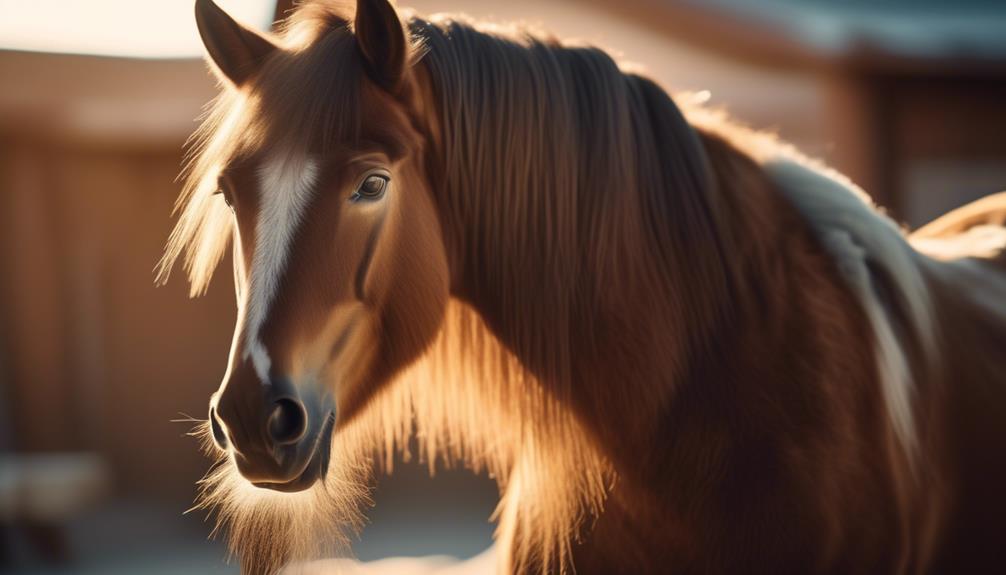
Using the right tools and techniques is essential for effectively grooming your Mongolian horse and keeping them in optimal health. Regular grooming sessions are important for maintaining the horse's cleanliness, promoting blood circulation, and strengthening the bond between you and your horse. Here are some tools and techniques that you can use:
| Tools | Techniques |
|---|---|
| Curry comb | Use circular motions to remove dirt, dust, and loose hair from the horse's coat. |
| Body finishing brush | Gently brush the coat in the direction of hair growth to remove remaining debris and give the coat a smooth and shiny appearance. |
| Dandy brush | Use short, flicking motions to remove stubborn dirt and mud from the horse's coat. |
| Shedding blade | Use long, sweeping motions to remove excess hair during shedding seasons. |
| Mane comb and tail brush | Start from the ends and work your way up to detangle and smooth the horse's mane and tail. |
| Hoof pick | Clean the hooves and check for any signs of infection or injury. |
| Soft cloth | Use a soft cloth to clean sensitive areas like the eyes and ears.
Unique Features and Characteristics of the Mongolian Horse
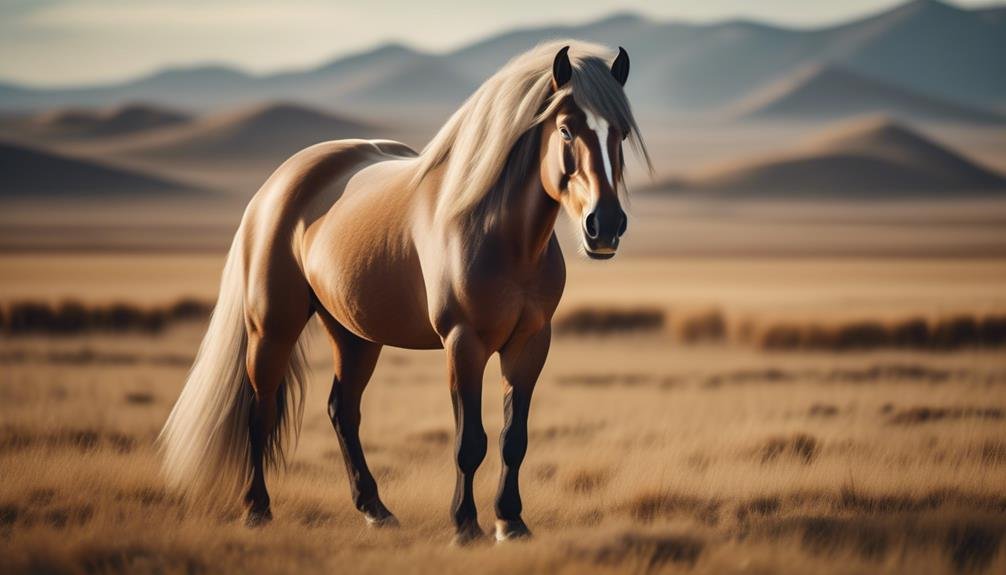
The Mongolian horse possesses a multitude of unique features and characteristics that set it apart from other equine breeds. These include:
- Adaptability: The Mongolian horse is incredibly adaptable to harsh climates and terrains, making it well-suited for the rugged Mongolian landscape.
- Endurance: Known for its exceptional endurance, the Mongolian horse can travel long distances without tiring, making it an ideal choice for long journeys and nomadic lifestyles.
- Intelligence: This breed is highly intelligent, with a sharp instinct and quick learning abilities, allowing it to navigate challenging situations and make smart decisions.
- Resilience: The Mongolian horse is incredibly resilient, capable of withstanding extreme weather conditions, scarcity of resources, and minimal human intervention.
- Surefootedness: With its strong and sturdy build, the Mongolian horse is surefooted on uneven terrains and can maneuver through difficult landscapes with ease.
These unique features and characteristics make the Mongolian horse a truly remarkable and invaluable breed, treasured by the people of Mongolia for centuries.
Frequently Asked Questions
What Are Some Common Health Issues That the Mongolian Horse Breed May Face?
Some common health issues that the Mongolian horse breed may face include respiratory problems, parasites, and hoof-related issues. Regular veterinary care, proper nutrition, and good hoof care can help maintain their overall health and well-being.
Are There Any Specific Training Techniques or Methods That Are Recommended for Working With Mongolian Horses?
There aren't any specific training techniques recommended for working with Mongolian horses. However, it's important to be patient, consistent, and use positive reinforcement. Building trust and establishing clear communication will help you form a strong bond with your horse.
How Does the Mongolian Horse's Temperament Compare to Other Ancient Horse Breeds?
The Mongolian horse's temperament is calm, friendly, and loyal, making it comparable to other ancient horse breeds. With some experience, you'll find this versatile breed to be affectionate and reliable.
Can the Mongolian Horse Be Used for Any Specific Disciplines or Activities, Aside From War and Sustenance?
The Mongolian horse can be used for a variety of disciplines and activities, aside from war and sustenance. Its versatility and talent make it suitable for horse owners and riders with some experience.
Are There Any Cultural Traditions or Rituals Associated With the Mongolian Horse Breed?
Yes, there are cultural traditions and rituals associated with the Mongolian horse breed. These include horse racing, known as "Naadam," and the use of horses in traditional ceremonies and celebrations.
What Makes Andalusian Horses Similar to Ancient Mongolian Horses in Terms of Versatility?
The versatile Andalusian horses legacy can be traced to their shared traits with ancient Mongolian horses. Both breeds are known for their adaptability, strength, and intelligence, making them suitable for a wide range of activities. Their versatility allows them to excel in various disciplines, making them highly sought-after breeds in the equestrian world.
Conclusion
In conclusion, the ancient Mongolian horse is a remarkable breed with a rich history and unique qualities. Their physical characteristics, loyal temperament, and versatile nature make them truly special.
Despite not being officially recognized, these horses are proudly maintained by indigenous and nomadic people in Mongolia. Their influence on other equine breeds is undeniable, and their grooming requirements are important for their well-being.
The Mongolian horse continues to captivate and awe with its enduring beauty and mysterious allure.

